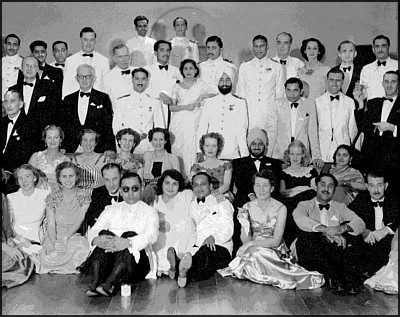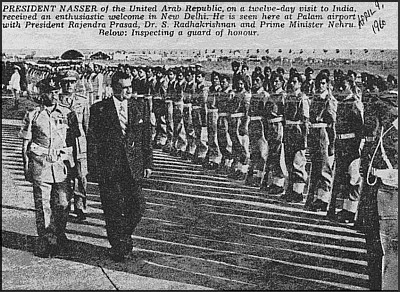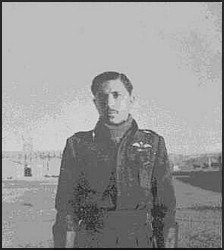After his flying accident in a Spitfire in WW2, which kept him from flying for some years, Wg Cdr Patel went on to the Joint Services Wing (JSW) at Dehradun. The JSW was later transformed into the National Defence Academy at Khadakvasla near Pune.
Prev: An airman’s war in WW2
After his flying accident in a Spitfire in WW2, which kept him from flying for some years, Wg Cdr Patel went on to the Joint Services Wing (JSW) at Dehradun. The JSW was later transformed into the National Defence Academy at Khadakvasla near Pune.
International Commission of Supervision and Control (Vietnam):
In 1954, the International Commission of Supervision and Control in Vietnam was set up by the United Nations to oversee the transition of three Indo-China countries – Laos, Vietnam and Cambodia – to independence from colonial rule. The ICSC consisted of staff from Canada, India and Poland with its Headquarters in Saigon. India was the Chairman of the ICSC from its inception until 1975. Wg Cdr Patel was deputed to this Commission in 1960.
“It was called the ICSC. There was some supervision but as for control, there was none. The North Vietnamese kept on getting their arms and ammunition from China, and the South Vietnamese kept on getting their arms and ammunition from America. But I had a fairly good stint, dealing with the Canadians on one side and the Poles on the other, both of whom very rarely on talking terms.
As the chairman of the team, I also made frequent visits to wherever the teams were located. There were 12 to 15 teams in North Vietnam and South Vietnam and one or two in Cambodia also. But Cambodia was low level at that time because they didn’t have a common border with China. On one occasion I was at Lao-Kai, which borders China, accompanied by the North Vietnamese liason officer. I noticed that Lao-Kai’s electricity power plant was very close to the bridge marking the border and remarked that in the event China and Vietnam ever went to war, poor Lao-Kai would be plunged into darkness because the power-station would be the first target to be taken out. The Vietnamese officer thought I was mad to even think their two countries would ever fight each other, however I reminded him that this was not inconceivable because China and Vietnam actually were ancient enemies. Unfortunately my prediction came true when the two went to war about 20 years later.
So the ICSC was actually an exercise in futility. I thank them for one thing in that I learnt a little bit of French, enough to talk to a shopkeeper or a chambermaid!”
By the 1960s, Indian participation in the International Commission of Supervision and Control in Vietnam decreased and Vietnam descended into the period of war, death and destructionwhich marked that period of its history. In 1975, the Commission was formally wound up.
Canberra Incident, 1959
Part of our discussion covered the interesting Canberra incident of 1959 which resulted in the shooting down of Sqn Ldr J C Sengupta over Pakistan. Wg Cdr Patel was in Air HQ at that time and he described to us the various reactions at the time of that incident. Wg Cdr Patel made prominent mention of the Canberra base commander, Wg Cdr K G Bhim Rao, and of Sengupta himself, quite often.
The 1962 Indo China War
Not too long after his stint in Vietnam, Wg Cdr Patel was sent to the IAF TAC Center attached to 4 Mountain Division in Tezpur. Here he was to meet up with an old friend from his days with No.1 Squadron under Majumdar. The Flight Commander of that time, Flt Lt Niranjan Prasad, had gone back to the Army and had risen to the rank of Major General. He was now the GOC of 4 Division.
“I remember the time from August, September ’62, when at that time Maj Gen Niranjan Prasad was a Division Commander, he was GOC 4 Infantry Division, and I was Senior Air Staff Officer of the TAC center attached to his division. Once he called me up and said “I am going to Tawang for a briefing, would you like to come with me?” I said “Wonderful” and off we went.
There we met Brigadier General John Dalvi, who was commanding a brigade. Brigadier Dalvi was also a good friend of mine. We came from the same college. He had played cricket for St Xavier’s College, in those days quadrangular and pentagular contests. And because of these college associations we became very friendly.
Brig Dalvi was using a sand model to give a briefing – what was being deployed where in case of a Chinese attack. The briefing went off fine, and once it was finished everybody left the room. John was putting away the stick and the chalk and the duster, I was still sitting there.
John Dalvi comes to me and says “So, Pat! How did it go?”.
I said , “John. Very nice briefing …very nice briefing. But you do know it’s all Bu****t.”
He said “What’s B*****t about it!
I said, “John. I am not an Army man but even I know that a brigade sector of defence is less than 500 yards per battalion. And you have only two battalions on hand, and the third one you have given away to Nagaland and Manipur. So you have got only two Brigades, and that too, ill-equipped. As it is, I’m cold now and your people are still in cottons, canvas shoes, even the coolie that carried me up to Tawang was grunting because of very thin air.” I continued, “Moreover, have you forgotten Korea? Have you learnt nothing from the Korean conflict about their tactics? You say they will not come from here, here and here? Well, that is EXACTLY where they will come from. And with their massed-attack tactics you will be swamped “.
Soon afterwards, General Kaul came to visit us. Gen Kaul blew the hell out of Niranjan Prasad because at that time, the Prime Minister, or the Defence Minister, had given the “Forward Policy”, of placing troops right on the border and Kaul was trying to get an explanation from Gen Prasad, in front of all of us, on why the forward troop movement had not been completed.
“If a man like me, a non-army man, could understand what the problem was, why couldn’t Gen Kaul understand? To put people right on the MacMahon Line – which is inaccessible – to supply them rations, to look after them medically, to manage their rotations. I told the General that our air force didn’t have so wide an organisation to supply all these people in small pockets, and give them food, and for casualty and altitude-sickness evacuation. And if he was going to put our people there, even if it was Border Security Force under an Army officer, the logistics problem would be colossal. I could understand all this, but I don’t know why this was not explained to General Kaul.
“So anyway, he blew his top and said, I want this thing done! And everybody got up and out and as I was leaving the room with two or three divisional staff officers I just blurted out. “You do that, and make just one bloody mistake and the Indian carpet will be rolled down the Himalayas!”
“Niranjan Prasad THWACKed be on the back “Shut up, Pat, they’ll hear!” I said. “Let them hear!!
“Soon after I had to go for School of Land-Air Warfare course. Trouble started with China and what I had said came true. By the time I went to the course, the Division had moved forward and Gen Kaul had established himself as a Corps Commander. I wrote an article on this for the Illustrated Weekly of India for the tenth anniversary in 1972.
After finishing the course I rushed to Tezpur when the war began. I met Gen. Niranjan Prasad at Tezpur airfield. He was leaving, very disappointed after being relieved of his command. Gen Kaul had already taken over. He was waiting, alone, at the Tezpur airfield for an Indian Airlines aircraft to take him to Delhi, or Army Headquarters, wherever he was going. Nobody from the Army was there to see him off. So I put him in my vehicle, took him to the Mess, gave him a beer and some lunch. Meanwhile the aircraft came. I said “Tell the aircraft to stand by. The General will be coming.” And then I saw him off. A low-ranked Air Force man had to see off a divisional commander!
“In the China war, I don’t blame Prasad one bit! He was a Gentleman commander and had very few resources at his disposal.”
Personalities of the 1962 War
Wg Cdr Patel had a ringside view of the debacle that followed and the hasty decisions taken at Corps HQ in Tezpur. He had seen all the Army personalities. We asked him if he recollected the other officers who were there at that time. Wg Cdr Patel offered his recollections on the following.
Bogey Sen – There were a certain number of people like General Sen, a Second World War DSO, along with people like Gen Rajendra Sinhji and Gen Thimmayya. But I think he may have started to go senile. I was at the office of Gen Kaul, people were discussing around the sand models and then the news came that Bomdi La had fallen. First there was pindrop silence, then Gen Kaul just walking up and down exclaiming “Oh my God, oh my God, oh my God!”. Gen Sen was bent down in his chair, head in his hands – that’s all. Not a word from him. Not a word. And the panic was chaotic, absolutely chaotic.
“First of all, General Kaul, I will take off my hat to him for being a superb administrator. But to put him in operations? Most of the Second World War, he spent in the Army Service Corps. When the war started, he was in a regular fighting force – then he went to the ASC. The war ended, he came back. That was no qualification. Frankly, I have no opinion of that man as a leader. He was not. When your Brigadier (Hoshiar Singh) calls up on radio from that pass (Se La), and says “This is what’s happening (we are being swamped). What should we do?” You know Kaul’s answer? “I don’t know- You do what you think is right”. Now is that the command from a commander? That good man ultimately got killed. Shot in the back, by the Chinese. Only if the General had said “Stand there and fight!” he would have done more. Instead he got a “Do what you think is right”. That’s not the way to command.
“Withdrawal, like defence and advance, is also a part of the Battle plan. It has got to have all the elements of command and control and support. [That] … was completely missing in 1962. And when there is no command, how can you have control? When you say “Do what you like, what you think fit.” No sir, that’s all wrong. You either say Fight and hold the line, or Retreat and make sure you plan it properly and if you want any help, let us know. It has to be a planned withdrawal. Not … a rout!
Brigadier Hoshiar Singh. A fine officer, and a gentleman. Even though I had never met him in my life, I had heard about his reputation. And my opinion of him as a gentleman was [because of] a little favour that he did to me. I was in Barrackpore and we were to build Officers’ Quarters besides the Men’s Quarters. And I wanted the blue prints of what they had done in the National Defence Academy. And I promptly got a lovely letter from him with those blue prints. And people who had worked with him, and know him, they had a very very high opinion about him.”
Wg Cdr Patel later wrote an article in the Illustrated Weekly of India in 1972, the tenth anniversary of the 1962 War. A copy of the article has been given to us and it will be put up online soon.
After the 62 War, Wg Cdr Patel moved to Secunderabad to SLAW.
1965 War
During the 1965 conflict Wg Cdr Patel was at the School of Land Air Warfare (now the College of Air Warfare). On the outbreak of the war, he was posted in Ahmedabad as a TAC Officer to 11 Division in the Rajasthan sector, which was under the command of Major General N C Rawlley MC, a veteran of the Imphal battle. Wg Cdr Patel had interacted with Gen Rawlley earlier in his career. One day Rawlley was visiting Ahmedabad and the army chaps asked Wg Cdr Patel if he wanted to come to the airport to receive him. At the line-up, they were surprised to see a Major General going out of his way to greet a Wing Commander by name!. Raised quite a few eye-brows…
Our meeting with Wg Cdr Patel ended with some very interesting anecdotes on the then Major General Sam Manekshaw, who took over from Kaul as the Corps Commander. One particular incident was in the mid-60’s when Gen Manekshaw was the Eastern Army Commander. At that time Wg Cdr Patel was also in the same sector and a request had come to him to provide a helicopter for Manekshaw. At the same time another request came in from a post that required an urgent medevac sortie. The General’s movement request was scrubbed and the helicopter was sent out by Wg Cdr Patel to carry out the medevac instead. Initially, Manekshaw was furious! When Wg Cdr Patel told him that between providing the helicopter to the GOC and to evacuating a sick soldier, wouldn’t the General agree that priority went to the casevac sortie, Manekshaw fumed “Dammit, I hate it when you are right”. Of course his remark was made in good spirit.
Retirement
Wg Cdr Patel finally retired from the Air Force in 1967, after nearly 27 years of service in uniform. He is currently settled in Bombay. While his son Naushad works in the finance industry, Wg Cdr Patel actively helps Naushad in his venture. At 83 years, he travels up and down the city by train, which can be a challenge to the strength of even a 20 year old! Meeting him that day in his apartment, the Bharat Rakshak team could not but marvel at Wg Cdr Patel’s crisp memory and sharp recollections. His memories cover a fascinating period, and certainly, what we had learned in one day was just a start. This may come as a shock to Wg Cdr Patel – but we do hope to spend still more time with him, drawing further on his memories and his opinions, again in the near future!


